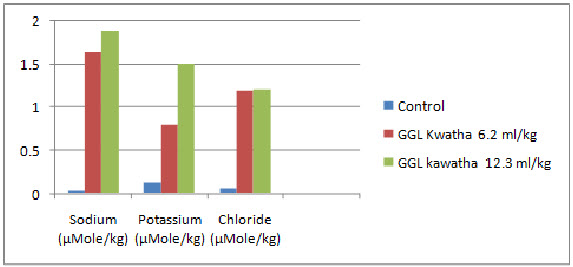{ DOWNLOAD AS PDF }
ABOUT AUTHORS:
Nandu Kayande1*, Pankaj Kushwah2
1HOD Department of Pharmacology
2Department of Pharmacognosy
Nimar Institute of Pharmacy, Dhamnod,
Opp.ITI, Maheshwar Road Dhamnod, Dhar. M.P.454552
nandu_kayande@rediffmail.com
ABSTRACT
The purpose of the present study was to evaluate the diuretic activity of glycyrrhiza glabra linn (Mulethi) in experimental animals by following the standard procedure. Randomly selected animals were divided into three groups of six animals each. The root of glycyrrhiza glabra linn was administered orally in the form of Kwatha at a dose of 6.2 ml/kg and 12.3 ml/kg. Parameters like volume of urine, pH of urine and urinary electrolyte concentrations like sodium, potassium and chloride were studied. glycyrrhiza glabra linn Kwatha increased the urine output in a dose-dependent manner. However, it did not affect the urinary electrolyte concentrations. From the present study, it can be concluded that the root of glycyrrhiza glabra linn has diuretic property.
INTRODUCTION
Glycyrrhiza glabra linn belonging to the family, fabaceae. Glycyrrhiza glabra, also known as licorice and sweet wood, is native to the Mediterranean and certain areas of Asia. Historically, the dried rhizome and root of this plant were employed medicinally by the Egyptian, Chinese, Greek, Indian, and Roman civilizations as an expectorant and carminative. In modern medicine, licorice extracts are often used as a flavoring agent to mask bitter taste in preparations, and as an expectorant in cough and cold preparations.
Deglycyrrhizinated licorice (DGL) preparations are useful in treating various types of ulcers, while topical licorice preparations have been used to sooth and heal skin eruptions, such as psoriasis and herpetic lesions. Its traditional uses include treating peptic ulcers, asthma, pharyngitis, malaria, abdominal pain, insomnia, and infections [1]. Decoction of the dried root is taken orally as a diuretic, depurative and emollient [2]. It is also used in the treatment of kidney stones [3] and stomach ache [4]. Licorice has been reported to have antioxidant [5], antiulcer[6], hepatoprotective [7], anti-asthmatic [8], anti-inflammatory, antiviral, anti-diabetic and anticancer activities. The classical Ayurvedic preparation of this plant called glycyrrhiza glabra linn Kwatha, prepared from the root of this plant, have shown excellent relief in patients of Mootrakruchchhra with symptoms of painful micturition and burning micturition. Hence, the present study was carried out to assess the diuretic activity of glycyrrhiza glabra linn root in form of Kwatha (decoction) in experimental animals and also to provide experimental basis to the clinical findings.
MATERIAL AND METHODS
Animals
Wistar strain albino rats of either sex, weighing between 180 and 200 g, were selected from the animal house attached to Nimar Institute of Pharmacy, Dhamnod. They were housed at 22±2°C with constant humidity 50–60%, on 12-hour natural day and night cycles. They were fed with diet a rat pellet feed and tap water ad libitum. The experiments were carried out in accordance with the directions of the Institutional Animal Ethics Committee (IAEC).
Procurement and preparation of test drug
The root samples of the test drug were collected from Nimar Regiondistrict Dhar by careful botanical identifications by Prof. Rao, Head of Department of Plant Anatomy and Botany, Khargone. The root samples were dried in shade and converted to coarse powder form. From the powder samples, Kwatha (decoction) was prepared freshly by referring the classical method,[9]just prior to administration to the animals. In brief, 16 parts of water and one part of the drug were boiled on a low flame till one-eighth of it remained. This was filtered and allowed to cool before administering to the animals.
Dose selection and schedule
In the classical texts, dose of GGL Kwatha is mentioned as 72 ml/day for an adult. Considering this, the dose of the experimental animals was calculated by extrapolating the human dose to animals as 6.2 ml/kg based on the body surface area ratio by referring and 12.3 ml/kg. The test drugs were administered orally with the help of a gastric catheter of suitable size sleeved onto a syringe nozzle at a constant volume to all the groups.
Experimental protocol
The diuretic activity was determined by following the procedure described by Saurabh Srivastav et al. (2011).[10] The selected animals were divided into three groups, with each group comprising three male and three female rats. The first group was kept as control, whereas the second and third groups were administered with GGL Kwatha at a dose of 6.2 and 12.3 ml/kg, respectively. The test drug and vehicles were administered to the overnight fasted rats of the respective groups. As the normal urine output in rats is very low (1–2 ml/rat/day), to get a measurable quantity of urine, the rats of all the groups were administered distilled water (2 ml/100 g) after 30 min of test drug administration. Then, the animals were placed individually in metabolic cages with netted floor and urine was collected in conical flasks placed below the polythene funnel of the metabolic cages. Extreme care was taken to avoid the contamination of urine with fecal matter. Urine was collected after drug administration at 1st, 2nd, 3rd, 4th and 5th hour. The urine volume was measured and analyzed for Na+, K+ (cations) and Cl−(anions). The concentration of Na+, K+ was analyzed by flame photometer[11] and the amount of chloride was determined titrimetrically by silver nitrite solution (0.1 N), using one drop of 5% ferric alum solution as indicator.[12] pH of urine was also measured using standard pH paper.
Statistical analysis
Results were presented as Mean ± SEM. Student's t test for unpaired data was used for analyzing the data generated during the study with the level of significance set at P<0.05. The level of significance was noted and interpreted accordingly.
RESULTS
Test drug increased the urine volume in a dose-dependent manner. Especially at higher dose level, statistically significant increase in urine volume was observed. Administration of test drug at both the doses did not affect the urine pH to a significant extent in comparison to normal control rats [Table 1].
Effects of GGL kwatha on urine volume and pH in hydrated rats.
|
Group |
Volume of Urine |
pH of Urine |
|
Control |
0.35±0.2 |
8.62±0.1 |
|
GGL Kwatha |
0.66±0.32 |
8.71±0.26 |
|
GGL Kwatha |
1.45±0.24 |
8.62±0.22 |
Table 1: Effect of GGL Kwatha on urine volume and pH in hydrated rats.
The effect of GGL Kwatha on urinary electrolyte concentration is shown in Table 2. Administration of GGL Kwatha in TED dose leads to statistically significant increase in urine sodium excretion, whereas in TED × 2 dose, it enhanced the urinary sodium excretion. GGL Kwatha also increases the urine potassium and chloride excretion to a significant extent [Table 2].
|
Groups |
Sodium (μMole/kg) |
Potassium (μMole/kg) |
Chloride (μMole/kg) |
|
Control |
0.021±0.001 |
0.12±0.12 |
0.054±0.01 |
|
GGL Kwatha |
1.65±0.12 |
0.8±0.08 |
1.19±0.014 |
|
GGL Kwatha |
1.89±0.11 |
1.51±0.32 |
1.21±0.009 |
Table 2: Effect of GGL Kwatha a on urinary electrolyte concentration (5 hours).

Graph: Effect of GGL Kwatha on urinary electrolyte concentration (5 hours).
CONCLUSION
Results from the present study show that GGL Kwatha can function as an orally active diuretic agent. The observed dose-dependent activity suggests that the observed effect was intrinsic. There are two factors on which urine volume depends. One is the rate of glomerular filtration and other is the degree of tubular re-absorption. The observed effect may be attributed to mechanism like increasing the renal blood flow and the attendant increase in glomerular filtration rate. It is also possible that it has inhibitory effect on antidiuretic hormone (ADH) secretion as inhibition of ADH causes polyurea. Another possible mechanism involved may be stimulation of release of endogenous natriuretic peptides, which promotes sodium and water secretion. Such a mode of action is unlikely as there was significant increase in urinary Na+ level.
To conclude, the root of GGL Kwatha has significant diuretic activity. The observed activity may be due to the individual or combined action of bioactive constituents present in it. Further phytochemical and pharmacodynamic studies are required to find the active constituent responsible for diuretic activity.
REFERENCES
1. Pizzorno JE, Murray MT. Textbook of Natural Medicine, 2nd Edition. Harcourt Publishers Limited 1999, 768.
2. Novaretti R, Lemordant D. Plants in the traditional medicine of the Ubaye Valley. J Ethnopharmacol. 1990 Aug; 30(1):1-34.
3. Dafni A, Yaniv Z, Palevitch D. Ethnobotanical survey of medicinal plants in northern Israel. Ethnopharmacol. 1984 May; 10(3):295-310.
4. Fujita T, Sezik E, Tabata M, Yesilada E, Honda G, Takeda Y, Taanka T, Takaishi Y. Traditional medicine in Trukey VII. Folk medicine in Middle and West Black Sea regions. Econ. Bot. 1995; 49(4):406-22.
5. Alternative Medicine Review. 2005; 10(3): p.230.
6. Asl MN, Hosseinzadeh H. Review of pharmacological effects of Glycyrrhiza Sp. and its bioactive compounds. Phytotherapy Research. 2008; 22(6):709-24.
7. Bafna PA, Balaraman R. Anti-ulcer and anti-oxidant activity of pepticare, a herbomineral formulation, Phytomedicine 2005 Apr; 12(4):264-70.
8. Dehpour AR, Zolfaghari ME, Samadian T, Kobarfard F, Faizi M, Assari M. Antiulceractivities of liquorice and its derivatives in experimental gastric lesion induced by ibuprofen in rats. Int. J Pharm. 1995, 119:133-38.
9. Sharangadhara samhita, by Pandit Sharangadharacharya, Adhamalla's Dipika and Kasiramas Gudhartha Dipika, Chaukhambha orientalia, Varanasi, fourth edition, 2000, 145.
10. Saurabh Srivastav, Pradeep Singh, Diuretic activity of whole plant extract of Achyranthes aspera Linn, European Journal of Experimental Biology, 2011, 1 (2):97-102.
11. Bishop, M. L., etal. (2000). Clinical Chemistry: Principles, Procedures, Correlations (4thed.). Philadelphia, PA: Lippincott Williams & Wilkins.
12. Preeti N. Pandya, Hetal B. Aghera, B. K. Ashok, and Rabinarayan Acharya, diuretic activity of Linaria ramosissima (Wall.) leaves in swiss albino mice. Ayu. 2012 Oct-Dec; 33(4): 576–578.
REFERENCE ID: PHARMATUTOR-ART-2176
|
PharmaTutor (ISSN: 2347 - 7881) Volume 2, Issue 6 Received On: 29/03/2014; Accepted On: 08/04/2014; Published On: 01/06/2014 How to cite this article: N Kayande, P Kushwah; Evaluation of Diuretic Activity of Glycyrrhiza Glabra Linn in Experimental Animals; PharmaTutor; 2014; 2(6); 167-170 |
NOW YOU CAN ALSO PUBLISH YOUR ARTICLE ONLINE.
SUBMIT YOUR ARTICLE/PROJECT AT articles@pharmatutor.org
Subscribe to Pharmatutor Alerts by Email
FIND OUT MORE ARTICLES AT OUR DATABASE









